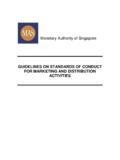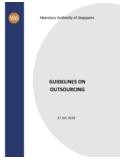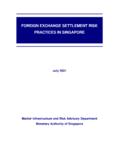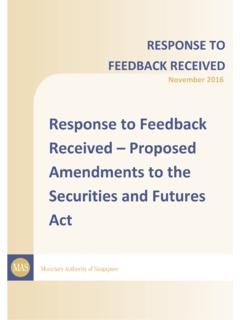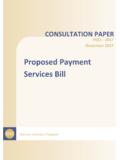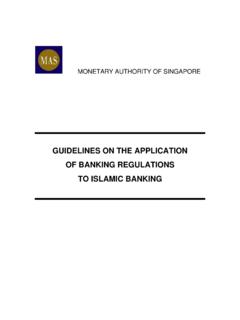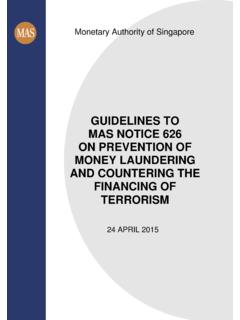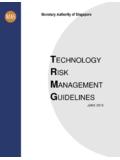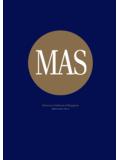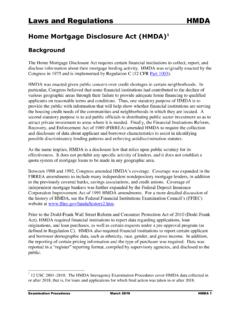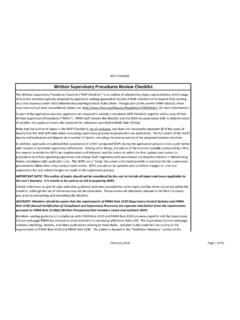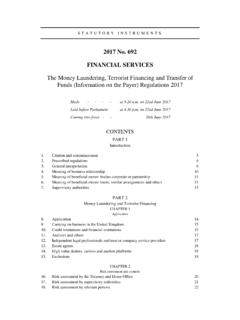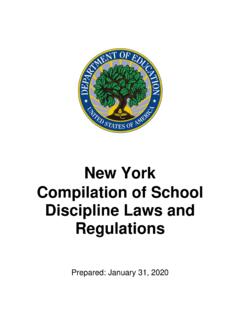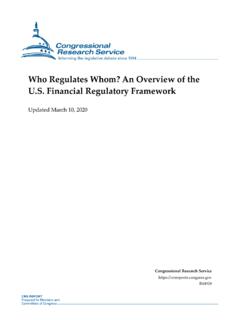Transcription of GUIDANCE FOR EFFECTIVE AML/CFT TRANSACTION …
1 Monetary Authority of Singapore GUIDANCE FOR EFFECTIVE AML/CFT TRANSACTION MONITORING CONTROLS September 2018 GUIDANCE FOR EFFECTIVE TRANSACTION MONITORING CONTROLS MONETARY AUTHORITY OF SINGAPORE 1 Table of Contents 1 Introduction .. 2 Use of this GUIDANCE Paper .. 4 2 Execution of TRANSACTION Monitoring .. 5 Knowing the Customer .. 5 Risk-based Calibration .. 5 Robust Implementation .. 10 Resolution and Enhancement .. 13 3 Risk Awareness .. 17 4 Governance .. 19 Material Outsourcing of First Level Alert Reviews .. 21 5 Conclusion .. 23 GUIDANCE FOR EFFECTIVE TRANSACTION MONITORING CONTROLS MONETARY AUTHORITY OF SINGAPORE 2 1 Introduction TRANSACTION monitoring ( TM ) is a key control in financial institutions ( FIs ) anti-money laundering and countering the financing of terrorism ( AML/CFT ) policies and procedures: When on-boarding customers, FIs are required to perform risk assessments and due diligence checks to identify and mitigate any prospective money laundering and terrorism financing ( ML/TF ) risks, including proliferation financing ( PF ) risks, at the onset.
2 However, risks can also manifest later, over the course of customers business relations with the FI. While these risk factors may be obscured at the on-boarding stage and during FIs performance of regular screening or periodic updates of customer information, they can often be detected through the robust conduct of TM. An EFFECTIVE TM system enables FIs to detect and assess whether customers transactions pose suspicion when considered against their respective backgrounds and profiles. TM systems also facilitate the holistic reviews of customer transactions over periods of time, in order to monitor for any unusual or suspicious trends, patterns or activities that may take place. An EFFECTIVE TM system is comprised of the following elements: A well-calibrated framework: The risks FIs face are dynamic and the transactions they carry out are varied and voluminous. FIs should therefore regularly review1 and enhance TM frameworks, and also do so when trigger events occur.
3 These reviews should be targeted at sustaining system effectiveness by imbibing the changing risk environment. Robust risk awareness: To ensure proper functioning and effectiveness of their TM systems, FIs must ensure that these are executed by competent and well-trained staff who exercise sound judgment in targeting unusual transactions , activities and behaviours. Meaningful integration: An FI s AML/CFT regime is as strong as its weakest link. FIs should therefore ensure that their TM systems and frameworks reinforce, and are reinforced by, the broader AML/CFT controls that they employ. FIs should designate 1 FIs with higher inherent risks or specific TM control deficiencies to address should perform more regular reviews in order to adequately mitigate their risks. GUIDANCE FOR EFFECTIVE TRANSACTION MONITORING CONTROLS MONETARY AUTHORITY OF SINGAPORE 3 clear responsibilities for the EFFECTIVE conduct of TM across their three lines of defence, that comprise: o FIs frontline staff, who must be adequately equipped to establish good understandings of their customers activities and behaviours, so as to alert their organisations to any unusual or suspicious activities in the first instance; o FIs compliance and support functions, which perform systems-based TM and should be adequately equipped, managed, and resourced in order to promptly identify, assess and report unusual or suspicious transactions ; and o Independent audit functions, which play an important role in testing and safeguarding the robustness of FIs TM performance.
4 Active oversight: Importantly, FIs board and senior management must take an active role in overseeing the satisfactory performance of TM. FIs board and senior management should drive the continual enhancement of their TM systems with a view to ensuring that their key risks are appropriately mitigated. When outputs or outcomes are compromised due to factors such as inappropriate calibration, process inefficiencies, staff issues or system failures, it is incumbent on the board and senior management to adequately resolve these matters in a prompt and timely manner. The board and senior management should communicate clear risk appetites within their organisations, and set a firm tone from the top that the detection, prevention and deterrence of ML, TF and PF are a priority. When properly executed, TM allows FIs to gain deeper insights into their customers profiles and behaviours, and strengthen their risk-based allocation of resources to tackling higher risk areas.
5 Conversely, TM lapses expose FIs to the heightened risk of abuse as they allow illicit fund flows to be manoeuvred through Singapore s financial system, escaping detection. The consequences of such lapses can be severe, implicating these FIs and Singapore s financial system as a refuge or conduit for illicit funds. GUIDANCE FOR EFFECTIVE TRANSACTION MONITORING CONTROLS MONETARY AUTHORITY OF SINGAPORE 4 Use of this GUIDANCE Paper Given the importance of robust TM, MAS conducted a series of AML/CFT banking inspections across Q4 2016 Q2 2018 that scrutinised the effectiveness of banks TM systems in the context of their broader AML/CFT regimes, using the following three pillar framework: This GUIDANCE paper reiterates the key recommendations by MAS to the inspected banks, setting out our supervisory expectations of sound practices for the EFFECTIVE conduct of TM. Additional context can be found in the box stories throughout the paper of case studies taken from MAS onsite findings and our recommendations to FIs.
6 The paper further highlights examples of best practices implemented by some of the inspected banks, which other FIs can consider emulating. Ultimately, while the paper does not impose any new regulatory obligations, FIs should nevertheless study and leverage on the GUIDANCE within to identify and address gaps in your execution of TM controls, to more effectively mitigate your ML/TF risks. While this GUIDANCE paper is derived from MAS banking inspection findings, the supervisory expectations and best practices therein are, with the appropriate modifications, equally relevant and applicable to other FIs. FIs should therefore incorporate the learning points from this GUIDANCE in a risk-based and proportionate manner, giving proper regard to the profile of their business activities and customers. In doing so, FIs should note that the takeaways in this paper are non-exhaustive, and they should continue to strengthen and refine their TM models according to their respective needs and context.
7 GUIDANCE FOR EFFECTIVE TRANSACTION MONITORING CONTROLS MONETARY AUTHORITY OF SINGAPORE 5 2 Execution of TRANSACTION Monitoring FIs should monitor and ensure the EFFECTIVE performance of TM at each stage of the TM process chain: Knowing the Customer EFFECTIVE TM is predicated on FIs sound understanding of their customers, which provides the necessary context for FIs to identify unusual/anomalous transactions and assess whether customers activity or behavioural patterns may pose reasonable suspicion. Before establishing business relations, FIs are required to perform customer due diligence ( CDD ) checks and assess the level of ML/TF risks posed by their prospective customers. In this regard, FIs should ensure that (i) their risk assessment frameworks and methodologies and (ii) the scope and extent of CDD measures that they apply are aligned with the requirements in MAS AML/CFT Notices, and more importantly enable them to detect and address risks posed by their customers.
8 After establishing a business relationship, FIs are required to maintain current and accurate knowledge of their customers through the performance of periodic reviews and/or reviews based on trigger events, and where appropriate enhance the frequency and intensity of customer engagement where the risks are assessed to be greater. Further GUIDANCE on the conduct of risk assessments and CDD will be set out in MAS upcoming GUIDANCE Paper on the findings and best practices from its AML/CFT inspections on capital markets intermediaries. Risk-based Calibration FIs are presently required to ensure that their TM systems are configured in view of their specific risks, contexts and needs. FIs with a larger scale of operations are expected to have in place automated systems capable of handling the risks from an increased volume and variance of transactions . While smaller FIs may rely on TM systems that are less automated, GUIDANCE FOR EFFECTIVE TRANSACTION MONITORING CONTROLS MONETARY AUTHORITY OF SINGAPORE 6 they must still ensure that these are appropriately executed to satisfactorily address the risks from their day-to-day TRANSACTION activities.
9 I. Parameter, Threshold and Scenario Setting When appropriately configured and implemented, TM parameters and thresholds enable FIs to flag unusual transactions with a reasonable degree of certainty of potential ML/TF characteristics warranting further inquiry. FIs should always ensure that their parameters and thresholds take into account their specific risks and context; and that they are appropriately back-tested for proper operation and effectiveness (see paragraph ). To this end, most banks perform risk-based customer segmentation in order to calibrate suitable parameters and thresholds for each segment, albeit there is room to improve how such segmentation is performed, and how the accompanying thresholds and parameters are derived. A good practice noted is that some banks have employed the use of certain statistical tools and methods such as above-the-line ( ATL ) and below-the-line ( BTL ) testing to better fine-tune their In addition, banks have grouped TM parameters and thresholds into risk scenarios to enable them to more precisely target TRANSACTION patterns and behaviours consistent with known ML/TF typologies such as smurfing, pass-through payments, or circular flows involving opaque structures.
10 Prior to implementing their HQs global TM parameters and scenarios, some banks performed assessments of the extent to which these parameters and scenarios complied with local requirements, and their effectiveness in addressing risks in the local context. Aside from those mentioned above, other risk areas that banks have developed scenarios to detect include: Large or complex transactions with no visible/apparent economic or lawful purpose Aggregated frequent and small transactions Unusual patterns of physical cash deposits or withdrawals, which are large when aggregated over a period of time Significant deviations from past account activity (or inactivity) TRANSACTION activities with nexus to higher risk countries or geographies Detection of activities or behaviours consistent with certain predicate offences ( possible tax evasion or avoidance, corruption nexus, or terrorism financing)
